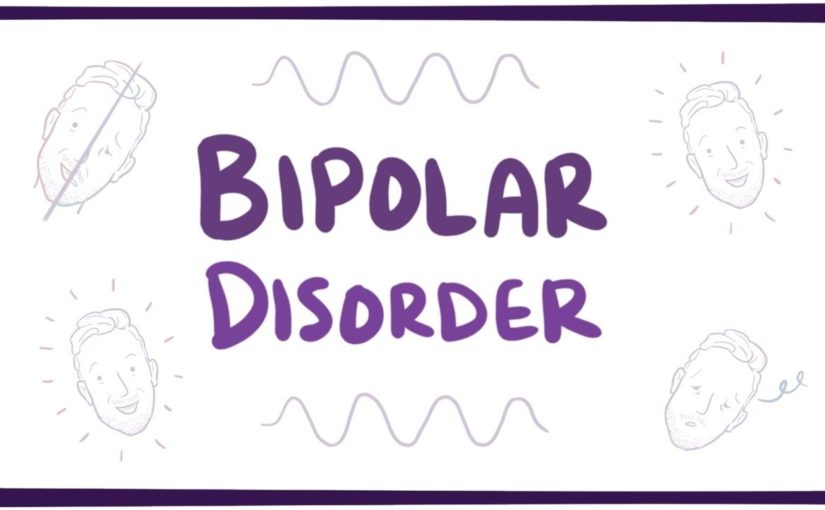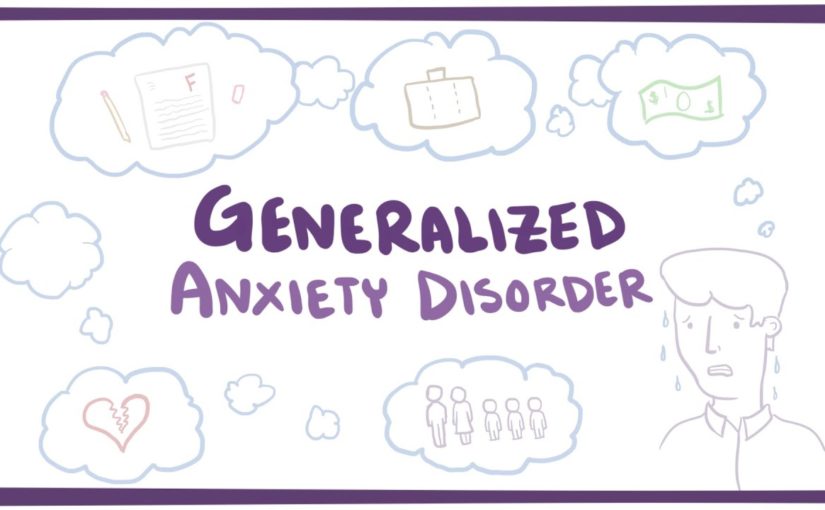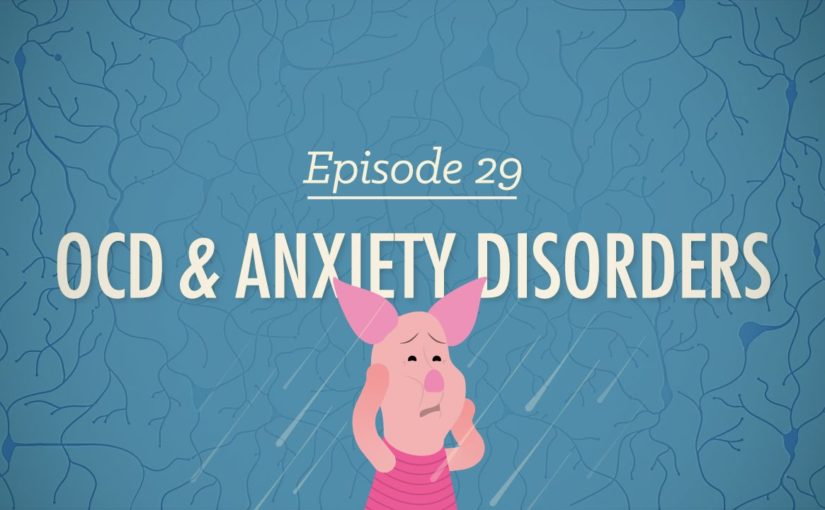Ever heard a really good joke about polio?
Or made a casual reference to someone having hepatitis? Or maybe teased your buddy by saying
he has muscular dystrophy? Of course you have never done that, because
you are not a terrible person. You’d never make fun of someone for having a physical
illness, but folks make all kinds of offhand remarks about people having mental illnesses
and never give it a second thought. How often have you heard a person say that
someone’s psycho, or schizo, or bipolar, or OCD? I can pretty much guarantee that the
people who used those terms had no idea what they actually meant. We’ve talked about how psychological disorders
and the people who have them have often been stigmatized. But at the same time, we tend to minimize
those disorders, using them as nicknames for things that people do, think, or say, that
may not exactly be universal, but are still basically healthy.
And we all do it, but only because we don’t
really understand those conditions. But that’s why we’re here, because as we go
deeper into psychological disorders, we get a clearer understanding of their symptoms,
types, causes, and the perspectives that help explain them. And some of the most common disorders have
their root in an unpleasant mental state that’s familiar to us all: anxiety. It’s a part of being human, but for some people
it can develop into intense fear, and paralyzing dread, and ultimately turn into full-fledged
anxiety disorder. Defining psychological disorders again: a
deviant, distressful, and dysfunctional pattern of thoughts, feelings, or behaviors that interferes
with the ability to function in a healthy way. So when it comes to anxiety, that definition
is the difference between the guy you probably called phobic because he didn’t like Space
Mountain as much as you did, and the person who truly can’t leave their house for fear
of interacting with others. It’s the difference between the girl who’s
teased by her friends as being OCD because she does her laundry every night and the girl who
has to wash her hands so often that they bleed.
Starting today, you’re going to understand
all of those terms you’ve been using. We commonly equate anxiety with fear, but
anxiety disorders aren’t just a matter of fear itself. A key component is also what we do to get
rid of that fear. Say someone almost drowned as a kid and is
now afraid of water. A family picnic at the river may cause that
anxiety to bubble up, and to cope, they may stay sequestered in the car, less anxious
but probably still unhappy while the rest of the family is having fun. So, in clinical terms, anxiety disorders are
characterized not only by distressing, persistent anxiety but also often by the dysfunctional
behaviors that reduce that anxiety. At least a fifth of all people will experience
a diagnosable anxiety disorder of some kind at some point in their lives.
That is a lot
of us. So I want to start out with a condition that
used to be categorized as an anxiety disorder but is now considered complex enough to be
in a class by itself, Obsessive-Compulsive Disorder or OCD. You probably know that condition is characterized
by unwanted repetitive thoughts, which become obsessions, which are sometimes accompanied
by actions, which become compulsions. And it is a great example of a psychological
disorder that could use some mental-health myth busting.
Being neat, and orderly, and fastidious does
not make you OCD. OCD is a debilitating condition whose sufferers
take normal behaviors like, washing your hands, or double checking that you turned off the
stove and perform them compulsively. And they often use these compulsive, even ritualistic
behaviors to relieve intense and unbearable anxiety. So, soon they’re scrubbing their hands every five minutes, or constantly checking the stove, or counting the exact number of steps they
take everywhere they go. If you’re still unclear about what it means
for disorders to be deviant, distressful and dysfunctional, OCD might help you understand. Because it is hard to keep a job, run a household,
sit still, or do much of anything if you feel intensely compelled to run to the kitchen
twenty times an hour. And both the thoughts and behaviors associated with
OCD are often driven by a fear that is itself obsessive, like if you don’t go to the kitchen
right now your house will burn down and your child will die which makes the condition that
much more distressing and self-reinforcing.
There are treatments that help OCD including certain
kinds of psychotherapy and some psychotropic drugs. But the key here is that it is not a description
for your roommate who cleans her bathroom twice a week, or the guy in the cubicle next to
you, who only likes to use green felt tip pens. And even though OCD is considered its own
unique set of psychological issues, the pervasive senses of fear, worry, and loss of control
that often accompany it, have a lot in common with other anxiety disorders.
The broadest of these is Generalized Anxiety
Disorder or GAD. People with this condition tend to feel continually
tense and apprehensive, experiencing unfocused, negative, and out-of-control feelings. Of course feeling this way occasionally is
common enough, but feeling it consistently for over six months – the length of time required for
a formal diagnosis – is not. Folks with GAD worry all the time and are
frequently agitated and on edge, but unlike some other kinds of anxiety, patients often can’t
identify what’s causing the anxiousness, so they don’t even know what to avoid. Then there’s Panic Disorder, which affects about
1 in 75 people, most often teens and young adults. It’s calling card is Panic Attacks or sudden
episodes of intense dread or sudden fear that come without warning. Unlike the symptoms of GAD which can be hard
to pin down, Panic Attacks are brief, well-defined, and sometimes severe bouts of elevated anxiety. And if you’ve ever had one, or been with someone
who has, you know that they call these attacks for good reason. They can cause chest pains and racing heartbeat,
difficulty breathing and a general sense that you’re going crazy or even dying.
It’s as
awful as it sounds. We’ve talked a lot about the body’s physiological
fight or flight response and that’s definitely part of what’s going on here, even though
there often isn’t an obvious trigger. There may be a genetic pre-disposition to
panic disorder, but persistent stress or having experienced psychological trauma in the past
can also set you up for these attacks. And because the attacks themselves can be
downright terrifying, a common trigger for panic disorder is simply the fear of having
another panic attack. How’s that for a kick in the head? Say you have a panic attack on a bus, or you
find yourself hyperventilating in front of dozens of strangers with nowhere to go to
calm yourself down, that whole ordeal might make you never want to be in that situation
again, so your anxiety could lead you to start avoiding crowded or confined places.
At this point the initial anxiety has spun
of into a fear of anxiety which means, welcome you’ve migrated into another realm of anxiety
disorder, Phobias. And again this is a term that’s been misused
for a long time to describe people who, say, they don’t like cats, or are uncomfortable
on long plane trips. Simply experiencing fear or discomfort doesn’t
make you phobic. In clinical terms, phobias are persistent,
irrational fears of specific objects, activities, or situations, that also, and this is important,
leads to avoidance behavior. You hear a lot about fears of heights, or
spiders, or clowns, and those are real things. They’re specific phobias that focus on particular
objects or situations. For example, the Chesapeake Bay Bridge in
Maryland is a seven-thousand meter span that crosses the Chesapeake Bay, if you want to
get to or from Eastern Maryland that’s pretty much the only way to do it, at least in a
car, but there are thousands of people who are so afraid of crossing that bridge that
they simply can’t do it.
So, to accommodate this avoidance behavior,
driver services are available. For $25 people with Gephyrophobia, a fear of bridges,
can hire someone to drive themselves, and their kids, and dogs, and groceries across the bridge
in their own car, while trying not to freak out. But other phobias lack such specific triggers,
what we might think of as social phobia, currently known as social anxiety disorder, is characterized
by anxiety related to interacting or being seen by others, which could be triggered by
a phone call, or being called on in class, or just thinking about meeting new people. So you can probably see at this point how
anxiety disorders are related and how they can be difficult to tease apart. The same thing can be said about what we think
causes them. Because much in the same way anxiety can show
up as both a feeling like panic, and a thought, like is my kitchen on fire, there are also two main
perspectives on how we currently view anxiety as a function of both learning and biology.
The learning perspective suggests that things
like, conditioning, and observational learning and cognition, all of which we’ve talked about
before best explain the source of our anxiety. Remember our behaviorist friend, John B. Watson
and his conditioning experiments with poor little Albert, by making a loud scary noise
every time you showed the kid a white rat, he ended up conditioning the boy to fear any
furry object, from bunnies, to dogs, to fur coats. That conditioning used two specific learning processes
to cement itself in Little Albert’s young mind. Stimulus Generalization, expanded or generalized
his fear of the rat to other furry objects, the same principle holds true if you were,
like, attacked by your neighbours mean parrot and subsequently fear all birds.
But then the anxiety is solidified through
reinforcement, every time you avoid or escape a feared situations, a pair of fuzzy slippers
or a robin on the street, you ease your anxiety, which might make you feel better temporarily,
but it actually reinforces your phobic behavior, making it stronger. Cognition also influences our anxiety, whether
we interpret a strange noise outside as a hungry bear, or a robber, or merely the wind,
determines if we roll-over and keep snoring, or freak out and run for a kitchen knife. And we might also acquire anxiety from other
people through observational learning. A parent who’s terrified of water may end
up instilling that fear in their child by violently snatching them away from kiddie
pools or generally acting anxious around park fountains and duck ponds.
But there’re also equally important biological
perspectives. Natural selection, for instance, might explain why we seem to fear certain potentially
dangerous animals, like snakes, or why fears of heights or closed in spaces are relatively
common. It’s probably true that our more wary ancestors
who had the sense to stay away from cliff edges and hissing serpents were more likely
to live another day and pass along their genes, so this might explain why those fears can
persist, and why even people who live in places without poisonous snakes would still fear
snakes anyway.
And then you got the genetics and the brain
chemistry to consider. Research has shown for example that identical
twins, those eternal test subjects, are more likely to develop phobias even if they’re
raised apart. Some researchers have detected seventeen different
genes that seem to be expressed with various anxiety disorders. So it may be that some folks are just naturally
more anxious than others and they might pass on that quality to their kids. And of course individual brains have a lot
to say about how they process anxiety. Physiologically, people who experience panic
attacks, generalized anxiety, or obsessive compulsions show over-arousal in the areasof the brain that deal in impulse control and habitual behaviors. Now we don’t know whether these irregularities
cause the disorder or are caused by it, but again, it reinforces the truism that everything that
is psychological is simultaneously biological. And that holds true for many other psychological
disorders we’ll talk about in the coming weeks, many of which have names that you’ve also
heard being misused in the past.
Today you learned what defines an anxiety
disorder, as well as the symptoms of obsessive compulsive disorder, generalized anxiety disorder,
panic disorder and phobias. You also learned about the two main perspectives
on the origins of anxiety disorders, the learning perspective and the biological perspective
and hopefully you learned not to use “OCD” as a punch line from now on. Thanks for watching, especially to all of
our Subbable subscribers who make Crash Course available to them and also to everyone else. To find out how you can become a supporter
just go to subbable.com/crashcourse. This episode was written by Kathleen Yale,
edited by Blake de Pastino, and our consultant is Dr.
Ranjit Bhagwat. Our director and editor is Nicholas Jenkins,
the script supervisor is Michael Aranda who is also our sound designer and the graphics
team is Thought Cafe..
 Pythagorean Betting System ꆛシ➫ The Pythagorean Betting System is my ultimate way to find out which team is undervalued and overvalued in all the major professional leagues, including NBA, MLB, NFL, and NHL. 8 months later, the user says: “The Pythagorean Betting System is … 18:07 The latest testimonial from Anders in Norway. He says: “The Pythagorean Betting System is amazing!… Every day you’re not inside, you’re losing money! God bless you Champ. It’s been an amazing ride!”
Pythagorean Betting System ꆛシ➫ The Pythagorean Betting System is my ultimate way to find out which team is undervalued and overvalued in all the major professional leagues, including NBA, MLB, NFL, and NHL. 8 months later, the user says: “The Pythagorean Betting System is … 18:07 The latest testimonial from Anders in Norway. He says: “The Pythagorean Betting System is amazing!… Every day you’re not inside, you’re losing money! God bless you Champ. It’s been an amazing ride!”


 Sometimes, people with Bipolar disorder can
show other, less common symptoms as well, for example having what is referred to as
mixed episodes—experiencing symptoms of both depression and mania at the same time. Another symptom they might have is rapid cycling,
which describes a situation where a person has 4 or more episodes of depression or mania
within a given year. Like most mental health conditions, the exact
the underlying cause of the bipolar disorder isn’t known, and there is no single “bipolar gene”
identified, but it’s thought that there are genetic and environmental factors that
play a part. For example, one interesting clue is that
people with family members who have bipolar disorder are 10 times more likely to have
it themselves. Another clue is that some drugs and medications
can trigger manic episodes, like selective serotonin reuptake inhibitors (or SSRIs). It’s also worth mentioning that people with
bipolar disorder often have other disorders like anxiety disorders, substance use disorders,
ADHD, and personality disorders as well, making diagnosis and treatment a real challenge. Even though there’s no cure for bipolar
disorder, identifying and treating individuals is important, since there’s a real
danger that the person could harm themselves or commit suicide. One of the oldest treatments is also one of
the most effective treatments, and that’s lithium salts. Lithium acts as a mood stabilizer—smoothing
out the highs and lows they experience. That said, it is much better at treating manic
rather than depressive episodes, and so individuals who take it often have to take other medications
as well, which can be problematic since some antidepressants (like the SSRIs) can trigger
manic episodes in individuals who are predisposed to them. Other treatment options include antipsychotics,
anticonvulsants, and benzodiazepines, but many of these—including lithium—have side
effects that can be severe and lead to non-adherence which can be dangerous for an individual. Now, unlike certain disorders like unipolar
depression, psychological interventions, like talk therapy, or cognitive-behavioral therapy
are not particularly effective in treating the manic episodes of bipolar disorder. Having said that, they can still be very helpful
tools to help individuals with bipolar disorder in general—especially after a manic episode
has ended. They can also help an individual handle stressful
situations that might otherwise lead to a manic episode, thereby helping to prevent a potential
manic episode in the first place. Alright, so super fast recap: bipolar disorder
is a mental disorder characterized by depression, periods of lowered mood, as well as mania,
and periods of heightened mood. Thanks for watching, you can help support
us by donating on Patreon, subscribing to our channel, or telling your friends about
us on social media.
Sometimes, people with Bipolar disorder can
show other, less common symptoms as well, for example having what is referred to as
mixed episodes—experiencing symptoms of both depression and mania at the same time. Another symptom they might have is rapid cycling,
which describes a situation where a person has 4 or more episodes of depression or mania
within a given year. Like most mental health conditions, the exact
the underlying cause of the bipolar disorder isn’t known, and there is no single “bipolar gene”
identified, but it’s thought that there are genetic and environmental factors that
play a part. For example, one interesting clue is that
people with family members who have bipolar disorder are 10 times more likely to have
it themselves. Another clue is that some drugs and medications
can trigger manic episodes, like selective serotonin reuptake inhibitors (or SSRIs). It’s also worth mentioning that people with
bipolar disorder often have other disorders like anxiety disorders, substance use disorders,
ADHD, and personality disorders as well, making diagnosis and treatment a real challenge. Even though there’s no cure for bipolar
disorder, identifying and treating individuals is important, since there’s a real
danger that the person could harm themselves or commit suicide. One of the oldest treatments is also one of
the most effective treatments, and that’s lithium salts. Lithium acts as a mood stabilizer—smoothing
out the highs and lows they experience. That said, it is much better at treating manic
rather than depressive episodes, and so individuals who take it often have to take other medications
as well, which can be problematic since some antidepressants (like the SSRIs) can trigger
manic episodes in individuals who are predisposed to them. Other treatment options include antipsychotics,
anticonvulsants, and benzodiazepines, but many of these—including lithium—have side
effects that can be severe and lead to non-adherence which can be dangerous for an individual. Now, unlike certain disorders like unipolar
depression, psychological interventions, like talk therapy, or cognitive-behavioral therapy
are not particularly effective in treating the manic episodes of bipolar disorder. Having said that, they can still be very helpful
tools to help individuals with bipolar disorder in general—especially after a manic episode
has ended. They can also help an individual handle stressful
situations that might otherwise lead to a manic episode, thereby helping to prevent a potential
manic episode in the first place. Alright, so super fast recap: bipolar disorder
is a mental disorder characterized by depression, periods of lowered mood, as well as mania,
and periods of heightened mood. Thanks for watching, you can help support
us by donating on Patreon, subscribing to our channel, or telling your friends about
us on social media.

